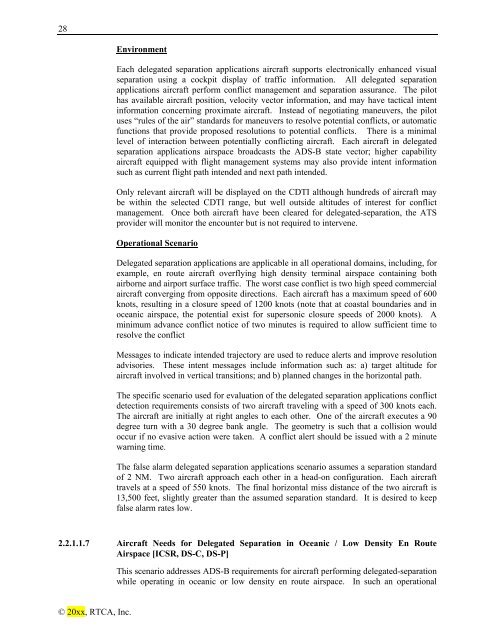Minimum Aviation System Performance Standards for Aircraft ...
Minimum Aviation System Performance Standards for Aircraft ...
Minimum Aviation System Performance Standards for Aircraft ...
You also want an ePaper? Increase the reach of your titles
YUMPU automatically turns print PDFs into web optimized ePapers that Google loves.
28<br />
Environment<br />
Each delegated separation applications aircraft supports electronically enhanced visual<br />
separation using a cockpit display of traffic in<strong>for</strong>mation. All delegated separation<br />
applications aircraft per<strong>for</strong>m conflict management and separation assurance. The pilot<br />
has available aircraft position, velocity vector in<strong>for</strong>mation, and may have tactical intent<br />
in<strong>for</strong>mation concerning proximate aircraft. Instead of negotiating maneuvers, the pilot<br />
uses “rules of the air” standards <strong>for</strong> maneuvers to resolve potential conflicts, or automatic<br />
functions that provide proposed resolutions to potential conflicts. There is a minimal<br />
level of interaction between potentially conflicting aircraft. Each aircraft in delegated<br />
separation applications airspace broadcasts the ADS-B state vector; higher capability<br />
aircraft equipped with flight management systems may also provide intent in<strong>for</strong>mation<br />
such as current flight path intended and next path intended.<br />
Only relevant aircraft will be displayed on the CDTI although hundreds of aircraft may<br />
be within the selected CDTI range, but well outside altitudes of interest <strong>for</strong> conflict<br />
management. Once both aircraft have been cleared <strong>for</strong> delegated-separation, the ATS<br />
provider will monitor the encounter but is not required to intervene.<br />
Operational Scenario<br />
Delegated separation applications are applicable in all operational domains, including, <strong>for</strong><br />
example, en route aircraft overflying high density terminal airspace containing both<br />
airborne and airport surface traffic. The worst case conflict is two high speed commercial<br />
aircraft converging from opposite directions. Each aircraft has a maximum speed of 600<br />
knots, resulting in a closure speed of 1200 knots (note that at coastal boundaries and in<br />
oceanic airspace, the potential exist <strong>for</strong> supersonic closure speeds of 2000 knots). A<br />
minimum advance conflict notice of two minutes is required to allow sufficient time to<br />
resolve the conflict<br />
Messages to indicate intended trajectory are used to reduce alerts and improve resolution<br />
advisories. These intent messages include in<strong>for</strong>mation such as: a) target altitude <strong>for</strong><br />
aircraft involved in vertical transitions; and b) planned changes in the horizontal path.<br />
The specific scenario used <strong>for</strong> evaluation of the delegated separation applications conflict<br />
detection requirements consists of two aircraft traveling with a speed of 300 knots each.<br />
The aircraft are initially at right angles to each other. One of the aircraft executes a 90<br />
degree turn with a 30 degree bank angle. The geometry is such that a collision would<br />
occur if no evasive action were taken. A conflict alert should be issued with a 2 minute<br />
warning time.<br />
The false alarm delegated separation applications scenario assumes a separation standard<br />
of 2 NM. Two aircraft approach each other in a head-on configuration. Each aircraft<br />
travels at a speed of 550 knots. The final horizontal miss distance of the two aircraft is<br />
13,500 feet, slightly greater than the assumed separation standard. It is desired to keep<br />
false alarm rates low.<br />
2.2.1.1.7 <strong>Aircraft</strong> Needs <strong>for</strong> Delegated Separation in Oceanic / Low Density En Route<br />
Airspace [ICSR, DS-C, DS-P]<br />
© 20xx, RTCA, Inc.<br />
This scenario addresses ADS-B requirements <strong>for</strong> aircraft per<strong>for</strong>ming delegated-separation<br />
while operating in oceanic or low density en route airspace. In such an operational

















